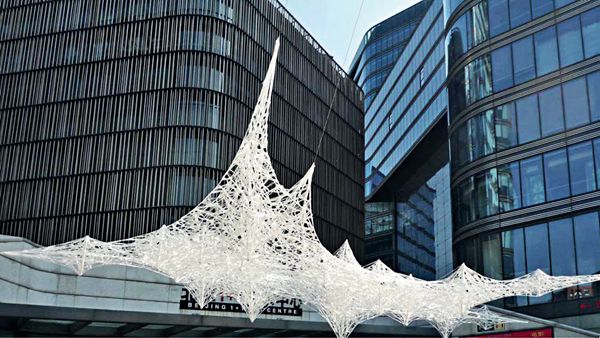For the Love of Art
China Today, January 23, 2017 Adjust font size:

A piece by French artist Ludwika Ogorzelec.
The results of the application of this theory can clearly be seen in the works displayed in the latest residency exhibition, as well as in the pieces kept in the permanent collection. Many of the works seem to be exploring lost culture. Traditional symbols are hidden in complicated designs or combined in unexpected ways to form new images. Mythical Chinese monsters, lotus plants, clouds, and Chinese characters and seals peep out from behind multiple layers of multicolored paint. Sometimes what appears to be a traditional symbol or approach will, on closer inspection, prove to be something completely different – almost as though the symbol is purely superficial and does not bear close scrutiny.
Cheng introduces us to one of her favorite paintings, by Wei Pen, a former resident artist. At a distance, it appears a traditional composition of bamboo and rock. “Go a bit closer,” she says, and we dutifully shuffle forward. As we approach, the bamboo morphs into scaffolding held in place with iron shards, and the rock is in fact a misshapen lump of concrete, studded with rusty iron staples. “I particularly like this painting,” she says, reflectively, explaining that it embodies both a personal and a collective pain, confronting a deep sense of loss. In this particular painting she sees a profound wisdom.
This idea of collective pain is echoed by Su Menglei, the resident poet, as we make a tour of the exhibition together. “Good art is about pain,” he says, pausing to look at a painting in various shades of grey, “and happiness,” he adds, wryly, “a mixture of the two.” There is something about Shangyuan which is calculated to deliver both in equal measure. The rural location, basic facilities (one shared shower room, no outside lights), spartan living quarters and a lack of amenities, actually aids contemplation – a little discomfort makes for huge artistic gains. Hard work is the norm here, but there is always time for socializing. Many of the work sessions, such as the tri-weekly meetings to share ideas, the music rehearsals, concerts, and exhibitions, are so collective as to be naturally social events. There are also parties and communal dinners. Living here is no real hardship then, but a lot of fun. This careful balance helps each resident to carve a path of self-discovery, to achieve something new in their own work, or, if they are very ambitious, a “new thing” in China.